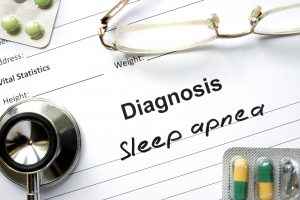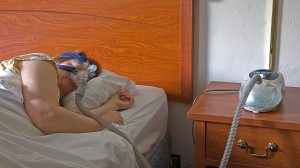Table of Contents
What Causes Obstructive Sleep Apnea

Knowing the first symptoms of obstructive sleep apnea is critical for getting the help you need.
When a person is suffering from obstructive sleep apnea, they experience shallow breathing and, in many cases, stop breathing altogether for brief periods of time while they sleep. For many people who suffer from sleep apnea, this can happen several times over the course of the night.
During sleep apnea, a patient’s upper airway is partially or completely blocked. This means that the patient’s chest muscles and diaphragm have to work harder in order to inhale and get air into the lungs. When breathing resumes, it is usually with a body jerk, loud gasp, or a snort. The patient will experience the effects of not sleeping well; however, in many cases, they absolutely have no idea why.
In addition to causing discomfort during sleep, sleep apnea causes irregular heart rhythms as well as diminishing the flow of oxygen to vital organs.
Sleep Apnea Symptoms
If you suspect that you or someone you know is suffering from sleep apnea, here are some of the signs that you should look out for:
- Night sweats
- Headaches when you wake up in the morning
- Daytime fatigue or sleepiness
- Issues with sex
- Dry mouth or sore throat after waking up
- Experiencing depression, forgetfulness, hard time concentrating, or irritability
- Waking up suddenly while gasping or because you choked
- Snoring etc
These symptoms usually manifest in adults but are different in children. Signs of sleep apnea in children include:
- Drooling or choking
- Bedwetting
- Problems at school
- Teeth Grinding
- Absence or pauses in breathing
- Snoring
- Plenty of sweating during the night
If you notice any of these signs, you should immediately get in touch with a doctor.
People that are likely to suffer from sleep apnea
Some people are at more risk of suffering from sleep apnea than others. If a person is obese or overweight, they will likely show symptoms of sleep apnea. Other groups of people that are at risk include people who:
- Have enlarged tonsils
- Have smaller airways
- Have too much tissue at the back of the throat
Also, men are at a higher risk of getting sleep apnea than women. The risk increases as a person grows older. A larger than average tongue can also block the airway in many people as well as deviated septum in the nose.
If a person has a large tongue prone to blocking the airway, they are likely to suffer from obstructive sleep apnea.
Other risk factors that increase the chances of getting sleep apnea include:
- Diabetes
- High blood pressure
- Smoking
- People who are prone to getting a stroke or suffering from heart failure
Diagnosis
For a proper diagnosis, the doctor will liaise with people who are familiar with your sleeping habits in order to gain a better understanding.

See a doctor immediately to get properly diagnosed if you suspect you might have sleep apnea.
The doctor will also require that you participate in a sleep study, either done in your home or a sleep lab. During the study, you will be required to wear monitors to measure things such as:
- Air Flow
- The electrical activity of the brain
- Breathing patterns
- Blood oxygen levels
- Heart rate
- Eye movements
- Muscle activity
- Treatment
Some of the possible treatments include:
- Weight loss
- Abstaining from sleeping pills and alcohol
- Nasal sprays
- Sleeping on your side
- CPAP Therapy
- Oral devices
- Surgery
Types of Surgery
Though CPAP therapy is considered the gold standard when it comes to the treatment of obstructive sleep apnea, surgery has also proven to be an effective form of therapy. There are different types of surgery, as listed below:
- Somnoplasty – During this procedure, doctors utilize radiofrequency energy to tighten the soft palate at the back of the throat.
- Upper airway stimulator – In this procedure, the surgeon places a pulse generator known as Inspire under the patient’s skin, that is, in their upper chest. One wire that goes to the lung detects the natural breathing pattern, while another wire that goes to the neck mildly stimulates nerves that control airway muscles, hence keeping them open.
- UPPP – This procedure increases the width of the airway at the throat opening. It involves removing soft tissue at the back of the palate and throat. Just in case you were wondering, UPPP is an acronym for Uvulopalatopharyngoplasty.
- Nasal surgery – This procedure corrects obstructions that are in the nose, for instance, a deviated septum.
- Maxillary advancement surgery – This surgery involves moving the face and jawbones forward in order to create more room at the back of the throat. It is a very complex procedure and is done on people who have problems with their face or head and who suffer from severe sleep apnea.
The Gold Standard for Obstructive Sleep Apnea Treatment
As mentioned before, CPAP therapy is considered the gold standard when it comes to treating sleep apnea. It involves using a CPAP machine that creates air pressure meant to keep your airways open when asleep. Though every patient does not tolerate this treatment, it is one of the least invasive and widely successful options for helping alleviate sleep apnea symptoms. Just like with medications and surgeries, though, there are still side effects and risks associated with CPAP therapy.
CPAP Therapy Maintenance

If you have to use a CPAP, contact Best CPAP Cleaner to get a CPAP cleaning machine to help make your sleep therapy more convenient today!
One of the biggest complaints of a CPAP user is the discomfort of the first couple of months when they are getting used to both the machine and how it feels when they are asleep and the maintenance and routine of using the equipment. Unfortunately, it is prone to get dirty and become a breeding ground for bacterial contaminants. This means that germs, molds, fungi, and even viruses can find the warm moist environment created by your face mask, hose, and humidifier tank the ideal place to grow. Because of this side effect of measures used to help you be more comfortable, you have to keep a strict cleaning regiment.
Typical cleaning processes for your CPAP gear is warm soapy water and a soft cloth. The biggest downfalls for this method of cleaning is that it can be messy, take up quite a lot of room, take a long time to dry, and it is easy not to have gotten everything 100% clean. Because most new CPAP users are already overwhelmed with all of the changes they have had to make to adapt to using their new device, we always recommend a good CPAP cleaning unit.
These CPAP disinfecting machines are automated and can have your CPAP equipment clean and ready to use in only minutes. With one touch of a button, your CPAP gear is sanitized and ready to go! Here at Best CPAP Cleaner, we offer three of the best selling CPAP cleaners available. Check out the Lumin and Lumin bullet, the VirtuCLEAN, and the SoCLean today!



 Shop
Shop



